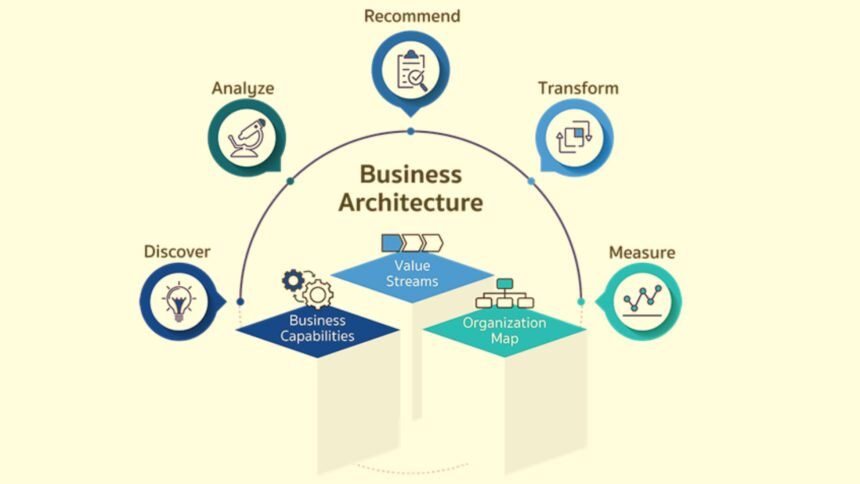Imagine running a company where every team, process, and strategy clicks like a perfectly tuned engine, driving growth without chaos. That’s the magic of business architecture, a discipline that’s quietly revolutionizing how American organizations operate. Whether you’re a startup founder in Silicon Valley or a corporate exec in Chicago, business architecture offers a strategic blueprint to align your vision, operations, and technology. In a world of rapid change—think AI, remote work, and global competition—this approach is your secret weapon. Let’s unpack what business architecture entails, weave in Reddit’s real-world insights, and explore how it can propel U.S. businesses to new heights in 2025, with expert guidance to light the way.
What Is Business Architecture?
At its heart, business architecture is about creating a holistic framework that connects a company’s strategy, processes, people, and technology. Think of it as the blueprint for how your organization functions—not just what you do, but how and why. For American businesses, it’s a way to ensure goals like profitability, customer satisfaction, or innovation are supported by streamlined operations. Unlike enterprise architecture, which dives deep into IT systems, business architecture focuses on the big picture, bridging executive vision with day-to-day execution.
On Reddit’s r/consulting, a user described it as, “The glue that keeps strategy from being just a PowerPoint dream.” This resonates with U.S. leaders who’ve seen great ideas fizzle without clear execution. Consequently, business architecture provides clarity, ensuring every department—from marketing to supply chain—rows in the same direction.
Why It’s Essential Today
American companies face unprecedented challenges—economic shifts, digital transformation, and workforce changes. Business architecture cuts through the noise by mapping capabilities, processes, and resources to strategic objectives. For instance, a retailer might use it to integrate e-commerce with brick-and-mortar stores, boosting customer experience. In 2025, with AI adoption soaring and hybrid work here to stay, this discipline ensures agility without chaos.
Reddit’s r/business notes, “Without a clear structure, scaling feels like herding cats.” For U.S. firms, from SMEs to Fortune 500s, business architecture prevents silos, aligns stakeholders, and unlocks efficiency, making it a must-have in today’s competitive landscape.
Business Architecture: Core Components
Every business architecture starts with strategy—your company’s North Star. This means defining goals, like market expansion or cost reduction, and tying them to capabilities. For example, a U.S. tech firm aiming to launch a new product might map out R&D, marketing, and distribution needs. Business architects translate executive vision into actionable plans, ensuring resources align with priorities.
A r/entrepreneur user shared, “Figuring out what we’re actually good at—our core capabilities—changed everything.” This clarity helps American businesses focus, avoiding costly detours. By grounding strategy in reality, business architecture turns ambition into results.
Processes and Capabilities
Processes are the how of your business—think order fulfillment, customer onboarding, or inventory management. Business architecture maps these, identifying gaps or redundancies. For instance, a logistics company might streamline delivery routes to cut costs. Capabilities, meanwhile, are what you’re good at—like data analytics or brand storytelling—and architects ensure they support strategic goals.
Reddit’s r/ProductManagement stresses, “Bad processes kill good ideas—mapping them saves you.” For American firms, this means optimized workflows that enhance productivity and customer satisfaction. By refining processes, business architecture fuels growth without bloat.
Technology and Data
Technology is the backbone of modern business architecture. Architects align IT systems—like CRM, ERP, or cloud platforms—with business needs. Data governance, another key piece, ensures analytics drive decision-making. For example, a U.S. retailer might use customer data to personalize marketing, boosting sales. In 2025, with AI tools proliferating, this alignment is critical.
A r/ITManagers user noted, “Our architect synced our tech with goals—suddenly, data wasn’t just noise.” For American businesses, business architecture ensures technology investments deliver ROI, not headaches, fostering innovation and resilience.
Benefits for American Businesses
Silos plague U.S. companies—marketing chasing leads while operations cuts costs, oblivious to each other. Business architecture breaks these walls, aligning teams around shared goals. For instance, a healthcare provider might unify patient care and billing to improve experience. This cohesion boosts efficiency and morale, vital in America’s fast-paced markets.
Reddit’s r/leanstartup loves this: “Alignment means no one’s working against the plan—huge time-saver.” For leaders, business architecture delivers clarity, ensuring strategies translate into results, not meetings.
Enabling Agility
Market shifts—like supply chain disruptions or consumer trends—demand flexibility. Business architecture builds adaptable frameworks, letting firms pivot without chaos. A manufacturer, for example, might retool production lines for sustainable products using existing capabilities. In 2025, with economic uncertainty lingering, this agility is a lifeline.
A r/businessanalysis user said, “Our architect mapped scenarios—helped us switch gears fast.” For American entrepreneurs, this means staying competitive, seizing opportunities while competitors scramble.
Challenges and Solutions
Business architecture can feel daunting—mapping processes, systems, and people takes time. Small businesses, in particular, might balk at the effort. Reddit’s r/smallbusiness warns, “Don’t overcomplicate it—start with one process.” Simplification is key; architects prioritize high-impact areas, like customer journeys, to deliver quick wins.
Additionally, stakeholder buy-in can be tricky. Executives might resist change, fearing disruption. Clear communication, showing ROI through metrics like cost savings, helps. For U.S. firms, starting small builds momentum, making complexity manageable.
Keeping It Relevant
Business architecture isn’t set-and-forget. Markets evolve, and frameworks must too. A retailer ignoring e-commerce trends risks obsolescence. Regular reviews—say, quarterly—keep architectures aligned with goals. Reddit’s r/consulting suggests, “Check your blueprint yearly; ours was outdated in six months.”
Moreover, talent gaps can stall progress. Business architects need strategic and technical skills, which are scarce. Training programs, like those from TOGAF or BizBok, help American professionals upskill, ensuring sustainability.
Getting Started with Business Architecture
Ready to embrace business architecture? Start by defining goals—revenue growth, customer retention, or digital transformation. Next, map capabilities and processes, using tools like ArchiMate or Lucidchart. Engage stakeholders—from C-suite to frontline—to ensure buy-in. For a U.S. startup, this might mean aligning product development with market needs.
Reddit’s r/Entrepreneurship advises, “Get a consultant for the first map—saves headaches.” For SMEs, external expertise accelerates setup, while corporates might build in-house teams. Either way, iteration refines your blueprint.
Leveraging Expertise
Business architects are rare gems, blending strategy, operations, and tech know-how. Certifications like CBAP or TOGAF signal credibility. Networking—via LinkedIn or conferences like BAWorld—connects you with pros. Reddit’s r/businessintelligence loves community input: “Crowdsourced our architecture on forums—game-changer.”
For American leaders, collaboration with consultants or peers sparks innovation. AI tools, like process mining software, also enhance mapping, making data-driven architecture a reality.
Expert Insights and Trends
Business architecture is evolving, and experts see it as mission-critical. Consultant Laura Bennett says, “Business architecture is the bridge between vision and victory—without it, strategies crumble.” Her insight underscores its role in execution, vital for U.S. firms facing global competition. In 2025, AI-driven architecture—using analytics to optimize processes—is trending, per r/technology.
Reddit’s communities echo this, with r/dataisbeautiful users sharing visualized architectures that simplify complexity. For Americans, staying ahead means embracing tech-enabled frameworks.
The Role of Community
Reddit—from r/business to r/consulting—offers raw wisdom. Users share case studies, like a retailer slashing costs via process maps, or pitfalls, like ignoring culture. Engaging these forums connects you with peers, sparking ideas. A r/startups user noted, “Reddit’s advice shaped our ops—real talk, no fluff.”
For U.S. leaders, community insights complement expertise, grounding business architecture in practicality. Joining discussions fuels innovation, ensuring your framework thrives.
Concluding Thoughts
Business architecture is the unsung hero American businesses need in 2025—a roadmap to turn vision into victory. From aligning teams to embracing tech, it empowers startups and corporates to thrive amid change. Reddit’s candid takes, paired with expert guidance, reveal its power: clarity, agility, and growth. Sure, complexity looms, but with smart steps, business architecture unlocks your potential.
So, grab a pen, map your future, and build a framework that soars. Whether you’re scaling or streamlining, business architecture is your edge. Here’s to smarter strategies and a bolder America—let’s make 2025 your breakout year!






